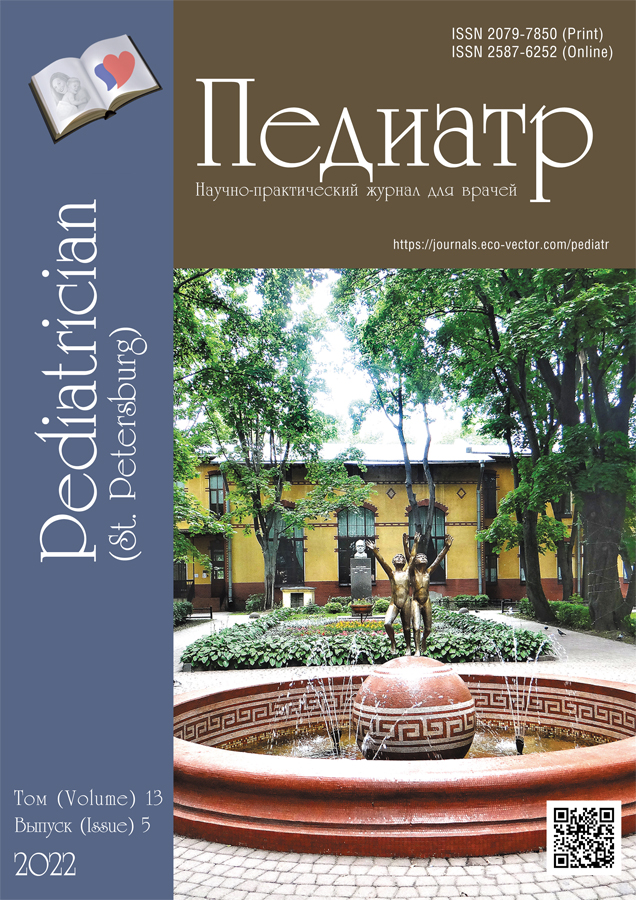Using cardiovascular parameters for determination of person’s gender identity
- Authors: Gorziy T.S.1, Belogurova E.A.1, Denisenko N.P.1, Denisenko M.D.1, Nikolaev V.I.1
-
Affiliations:
- North-Western State Medical University named after I.I. Mechnikov
- Issue: Vol 13, No 5 (2022)
- Pages: 43-50
- Section: Original studies
- URL: https://journals.eco-vector.com/pediatr/article/view/119957
- DOI: https://doi.org/10.17816/PED13543-50
- ID: 119957
Cite item
Abstract
BACKGROUND: Emotional stress is a significant risk factor for the development of cardiovascular diseases. Prenosological diagnostics of these conditions becomes important. The peculiarities of adaptive reactions are largely determined by individual psychological characteristics of an individual, including gender identity.
AIM: Determination of correlation of functional parameters of the cardiovascular system for objectification of psychological criteria for classification of gender identity.
MATERIALS AND METHODS: Hemodynamics and heart rate variability were studied in people with different gender identities. A total of 200 volunteers of both sexes were examined in a state of mental and physical rest. 14 parameters of cardiovascular activity were selected to construct discriminant functions: stroke volume of blood flow, cardiac output, cardiac index, stroke index, heart rate, standard deviation of R–R intervals, square root of the mean squared difference of successive R–R, percentage of R–R intervals with a sinus rhythm of the heart, which differ by more than 50 ms, index of vegetative equilibrium, vegetative rhythm index, indicator of the adequacy of regulatory processes, stress index of regulatory systems, indicator of the activity of regulatory systems. The obtained indicators and initial coefficients reflecting the contribution of each parameter to the discrimination of groups were used to calculate discriminant functions.
RESULTS: It was found that the graphs reflecting the results of discriminant analysis showed a high degree of accuracy in classifying men (97.6%) and women (96.5%) by gender identity based on objective characteristics of cardiovascular activity. The objectivity of psychological testing with a high probability of predicting the type of gender identity based on the analysis of rheography and rhythmocardiography data is shown.
CONCLUSIONS: The use of objective characteristics of cardiovascular activity obtained during rheography and rhythmocardiography made it possible to predict the type of a person’s gender identity with high probability.
Full Text
About the authors
Taisiya S. Gorziy
North-Western State Medical University named after I.I. Mechnikov
Author for correspondence.
Email: gortas@mail.ru
Assistant Professor, Department of Pathophysiology
Russian Federation, Saint PetersburgEvgeniya A. Belogurova
North-Western State Medical University named after I.I. Mechnikov
Email: Evgeniya.Belogurova@szgmu.ru
MD, PhD, Associate Professor, Department of Pathophysiology
Russian Federation, Saint PetersburgNataliya P. Denisenko
North-Western State Medical University named after I.I. Mechnikov
Email: Nataliya.Denisenko@szgmu.ru
MD, PhD, Dr. Sci. (Med.), Professor, Department of Pathophysiology
Russian Federation, Saint PetersburgMariya D. Denisenko
North-Western State Medical University named after I.I. Mechnikov
Email: Mariya.Denisenko@szgmu.ru
MD, PhD, Associate Professor, Department of Pathophysiology
Russian Federation, Saint PetersburgValentin I. Nikolaev
North-Western State Medical University named after I.I. Mechnikov
Email: Valentin.Nikolaev@szgmu.ru
MD, PhD, Dr. Sci. (Med.), Professor, Head of Department of Pathophysiology
Russian Federation, Saint PetersburgReferences
- Baevskii RM. Analiz variabel’nosti serdechnogo ritma: istoriya i filosofiya, teoriya i praktika. Klinicheskaya informatika i telemeditsina. 2004;(1):54–64. (In Russ.)
- Boytsov SA, Provatorov SI. Cardiovascular diseases in the Russian Federation: the main components of mortality and directions of prevention. Vestnik Roszdravnadzora. 2018;(5):12–18. (In Russ.)
- Narmetova YuK. Osobennosti psikhokorrektsionnogo podkhoda pri psikhosomaticheskikh zabolevaniyakh (na primere ishemicheskoi bolezni serdtsa). Gospodarka i Innowacje. 2022;21:258–261. (In Russ.)
- Nikolaev VI, Denisenko NP, Belogurova EA, et al. Features of cardiovascular system functioning under emotional stress in dependence of maskuline-feminine personality traits. Pediatrician (St. Petersburg). 2018;9(6):51–56. (In Russ.) doi: 10.17816/PED9651-56
- Cheshik IA, Sharshakova TM. Epidemiology of the most common risk factors causing the development of blood circulation diseases and their contribution to mortality of male able-bodied population. Health and Ecology Issues. 2018;(1):8–15. (In Russ.) doi: 10.51523/2708-6011.2018-15-1-2
- Enbrecht MO, Terekhov EA. Psychosomatic portrait of a hypertensive patient. Scientist. 2021;(3):6–9. (In Russ.)
- Bem SL. Gender schema theory: A cognitive account of sex typing. Psychol Rev. 1981;88(4):354–364. doi: 10.1037/0033-295X.88.4.354
- Bey GS, Ulbricht CM, Person SD. Theories for race and gender differences in management of social identity-related stressors: A systematic review. J Racial Ethn Health Disparities. 2019;6(1):117–132. doi: 10.1007/s40615-018-0507-9
- Faizan R, Nair SL, ul Haque A. The effectiveness of feminine and masculine leadership styles in relation to contrasting gender’s performances. Pol J Manag Stud. 2018;17(1):78–92. doi: 10.17512/pjms.2018.17.1.07
Supplementary files










